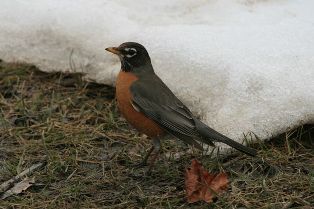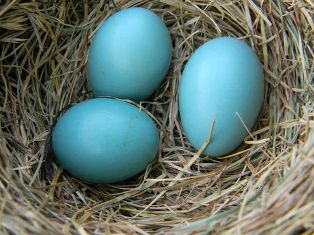"They're Back"
Well, it's March and the American robins (Turdus migatorius) are coming back. Robins are one of the earliest song birds to migrate back to Nebraska, with some arriving in mid-February. In recent years an increasing number of robins have been staying at their breeding sites in Nebraska the entire year.
The American robin is likely the most common songbird in Nebraska, taking up residency on acreages as well as in suburban and urbanized locations.
American robins are 9 to 11 inches long, weigh 3 ounces, and have a wingspan of 15 to 17 inches. The breast is tan to dark rusty red with males having a much brighter red coloration. They are usually darker gray to charcoal color on the head, back, and tail. The outer tips of the tail feathers are dipped with white. The name "American robin" is used because European settlers thought this bird looked like a larger version of the "Robin Red-breast," which is a completely different species.
In late winter, American robins mate and begin constructing nests. The nests are made of dry grass, small twigs, and mud. They usually will not use bird houses but rather prefer to build in tree crotches or small ledges. To attract a nesting robin, simply place a small, 4- to 8-inch square wooden shelf in a semi-protected location on a structure, such as under an eave. Robins commonly produce 2 to 3 broods in Nebraska a year. Unfortunately, only about a quarter of those fledged nestlings will survive to the next year. The robins that do survive can live up to 14 years, returning to the same breeding location year after year.
Robins prey on earthworms and insects in the native meadows and grasslands, as well as in lawns. They will feed on these items in the morning, then search out fruit and seed meals in the afternoon. Occasionally some robins will eat too much fermenting fruit and become intoxicated.
Robins are typically noticed foraging for food on the ground or building nests in trees and on ledges of structures. They can form very large roosting aggregations during late winter. In summer, females sleep at their nests and males gather at roosts. As young robins become independent, they join the males. Female adults go to the roosts only after they have finished nesting.


